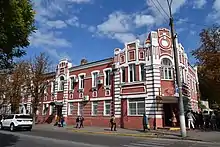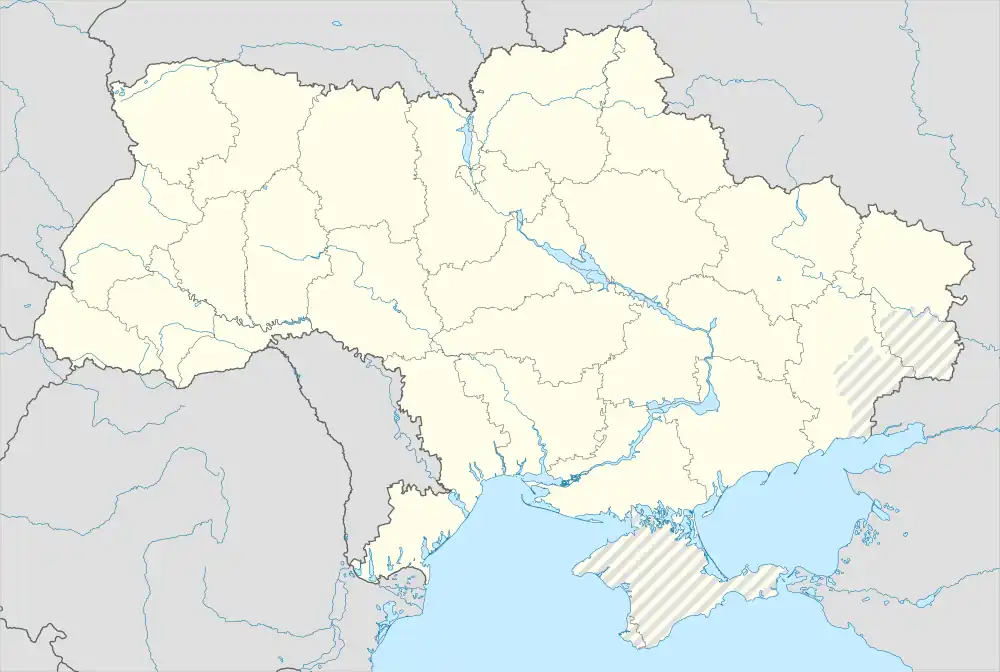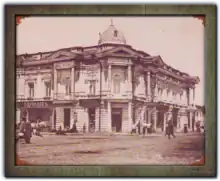Pavlohrad
Павлоград | |
|---|---|
   .jpg.webp) | |
 Flag  Coat of arms | |
 Pavlohrad  Pavlohrad | |
| Coordinates: 48°31′0″N 35°52′0″E / 48.51667°N 35.86667°E | |
| Country | |
| Oblast | |
| Raion | |
| Established | 1779 |
| City rights | 1784 |
| Government | |
| • Mayor | Anatolii Vershyna |
| Area | |
| • Total | 59.3 km2 (22.9 sq mi) |
| Highest elevation | 71 m (233 ft) |
| Population (2022) | |
| • Total | 101,430 |
| • Density | 1,700/km2 (4,400/sq mi) |
| Postal code | 51400-51429 |
| Area code | +380-5632 |
| Website | https://pavlogradmrada.dp.gov.ua |

Pavlohrad (Ukrainian: Павлоград, pronounced [pɐu̯loˈɦrɑd]) is a city and municipality in central east Ukraine, located within the Dnipropetrovsk Oblast. It serves as the administrative center of Pavlohrad Raion. Its population is approximately 101,430 (2022 estimate).[1]
The rivers of Vovcha (runs through the city 12.85 kilometres (7.98 mi) towards the Samara River), Hnizdka (3.9 kilometres (2.4 mi)), Kocherha (2.9 kilometres (1.8 mi)) flow through Pavlohrad. The area of the city is 59.3 square kilometres (22.9 sq mi). There are 20 schools and 1 lyceum in the city.
History
Pavlohrad, one of the oldest modern settlements in the Dnipropetrovsk oblast appears in documents from the 17th century.
At the beginning of the 1770s, Zaporozhian Cossack Matvii Khizhnyak built winter quarters, which soon became known as sloboda Matviivka (Russian: Матвеевка, romanized: Matveevka). In 1779, Matveevka was renamed to Luhanske, as the latter became headquarters of the Luhansk pikemen regiment headed by M. I. Golinishchev-Kutuzov. With the establishment of Yekaterinoslav Viceroyalty in 1783, Pavlohrad, re-named in honor of the future Emperor Paul І (r. 1796–1801), became a part of this administrative unit as a district town. In 1784, Pavlohrad received city status.
There were 426 homes and 2419 inhabitants in the city at the end of 18th century. The citizens of Pavlohrad lived in wattle and daub huts. The first stone building was the Svyato-Vosnesensky Cathedral on Soborna ploshcha (Eng.: cathedral square). The first coat of arms of the city was affirmed on July 29, 1811, the second one on September 26, 1979. The first citizens were Cossacks of Samarsky and Kalmiussky Palanki and demobilized military. The city plan by Scottish architect W. Geste was affirmed by emperor Nicholas I on July 31, 1831.

In 1871, local merchant A.K. Shalin was elected the first head of the city. The central street was named after him (ul. Shalinskaya, (eng: Shalinsky street) later renamed ul. Lenina, (eng.: Lenin street)). (In 2015, the Ukrainian government approved laws that outlawed communist symbols and street names.[2]) As of 2022 the street is named "Soborna". Merchant of ІІ Guild A.V. Permanin was elected as city governor in 1892. Under his leadership the city started to develop rapidly: several churches, temples, barracks, gymnasiums, factories and plants were built.
In the 1870s, a railway connecting St. Petersburg and Simferopol passed through Pavlohrad. In 1896, the Golenishchev-Kutuzov family built the "Earl's Theatre".
In 1930, an uprising against Soviet rule took place in Pavlohrad. From 1780 to 1941, a significant Jewish community existed in the city. The pre-Holocaust Jewish population was approximately 4,000. The city was destroyed in 1941 during the Nazi occupation. During the Holocaust the German occupying forces operated a concentration camp (Dulag 111) and a Jewish ghetto in Pavlohrad. A large part of the community died during the war and during the mass executions. The Pavlohrad Jewish cemetery contains not only Jewish, but also Christian burials, which the leaders of the local Jewish community agreed to in 1995.[3] On May 22, 2011, it was reported that unknown persons had desecrated the cemetery in the town - tombstones were turned over and broken in an apparently anti-Semitic act.[4]
Until 18 July 2020, Pavlohrad was incorporated as a city of oblast significance and served as the administrative center of Pavlohrad Raion though it did not belong to the raion. In July 2020, as part of the administrative reform of Ukraine, which reduced the number of raions of Dnipropetrovsk Oblast to seven, the city of Pavlohrad was merged into Pavlohrad Raion.[5][6]
During the 2022 Russian invasion of Ukraine, Pavlohrad — an important railway transportation hub — was subjected to Russian attacks. On 22 March, a missile strike destroyed the Pavlohrad-2 train station in the city, killing at least one person.[7]
Due to the law "On the Condemnation and Prohibition of Propaganda of Russian Imperial Policy in Ukraine and the Decolonization of Toponymy" (in April 2023 signed by President Volodymyr Zelenskyy) the city needs to be renamed.[8] According to law this renaming has to take place before 27 January 2024.[8]
Population
According to the 2001 Ukrainian census, the city's population was 119,672. Ukrainians accounted for 72.3% of the population and Russians for 25%.[9] Ukrainian was the native language for 59.2% of the population, and Russian for 39.8%.[10]
Pavlohrad Mechanical Plant
The city is home to Pavlohrad Mechanical Plant (PMZ) that was established in December 1963 as a specialized production facility of the Plant no. 586 (now Pivdenmash Production Association). PMZ is a factory dedicated to assembly, perfection and production of solid-fueled rocket engines and missiles. By 1975 PMZ became the largest solid-rocket factory within the Ministry of General Machine Building of USSR. PMZ made fuel tanks for booster rockets and plastic ICBM rocket motor casings; parts, components, and assemblies for aerospace systems manufacturing.
On 30th April 2023, a Russian attack on Pavlohrad caused a series of large explosions and fires, injuring at least 34 civilians. Ukrainian sources reported that a plant was hit that produced solid fuel for Soviet-era rockets, and had a number of motors awaiting decommissioning. Russian sources claimed that this attack disrupted the production of ammunition, weapons and military equipment for Ukrainian troops.[11]
Gallery
 A pedestrian alley in midtown Pavlohrad
A pedestrian alley in midtown Pavlohrad Tsentralna Street
Tsentralna Street Pavlohrad Railway Station
Pavlohrad Railway Station Dormition Cathedral
Dormition Cathedral Vernicle Cathedral
Vernicle Cathedral Holubytsky church
Holubytsky church
Twin towns — Sister cities
Pavlohrad is twinned with:
 Lubsko, Poland
Lubsko, Poland San Sebastián, Spain
San Sebastián, Spain
References
- ↑ Чисельність наявного населення України на 1 січня 2022 [Number of Present Population of Ukraine, as of January 1, 2022] (PDF) (in Ukrainian and English). Kyiv: State Statistics Service of Ukraine. Archived (PDF) from the original on 4 July 2022.
- ↑ Motyl, Alexander J. (28 April 2015). "Decommunizing Ukraine". Foreign Affairs. Retrieved 19 May 2015.
- ↑ "PAVLOHRAD JEWISH CEMETERY". Lo Tishrash. Archived from the original on 14 July 2014. Retrieved 30 September 2012.
- ↑ "Cemetery desecrated". CFCA. Retrieved 30 September 2012.
- ↑ "Про утворення та ліквідацію районів. Постанова Верховної Ради України № 807-ІХ". Голос України (in Ukrainian). 2020-07-18. Retrieved 2020-10-03.
- ↑ "Нові райони: карти + склад" (in Ukrainian). Міністерство розвитку громад та територій України.
- ↑ "At least 1 killed as Russian missile attack destroys Ukrainian train station, official says". CNN. 22 March 2022. Retrieved 22 March 2022.
- 1 2 Olena Burseva (4 August 2023). "Novomoskovsk, Pavlograd, Sinelnikove: what else will be renamed in the Dnipropetrovsk region in half a year". Informator (in Ukrainian). Retrieved 1 January 2024.
- ↑ https://datatowel.in.ua/pop-composition/ethnic-cities
- ↑ https://datatowel.in.ua/pop-composition/languages-cities
- ↑ "Ukraine ammunition depot reportedly hit in wave of Russian missile attacks". The Guardian. 2023-05-01. ISSN 0261-3077. Retrieved 2023-05-24.
External links
- The murder of the Jews of Pavlohrad during World War II, at Yad Vashem website.